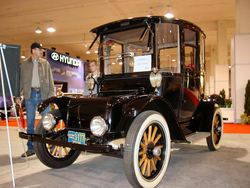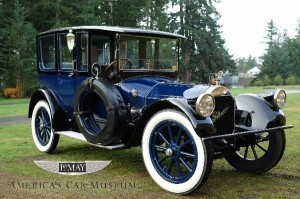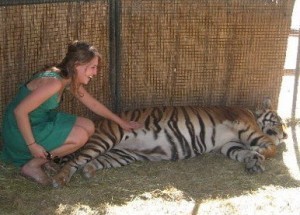Rolf Potts's Blog, page 90
June 17, 2012
Bashing “tourists” is itself a naïve gesture
Vagablogging :: Rolf Potts Vagabonding Blog
“The anti-tourist rhetoric of consumption usually goes like this: Your holidays demonstrate a lack of sophistication. You indulge in cheap pleasures and buy tacky souvenirs. You show no restraint or moderation, you overeat, overdrink, overspend. You are far too passive, just dozing in the hammock, hanging around the pool, or letting yourself be transported from sight to sight. You live beyond your means, squandering your money on the wrong things…your vacation experiences are shallow. We, on the other hand, have higher ambitions for our vacations. We want to experience new things, expand our minds, understand history or other cultures. We search for the genuine and the authentic. Even during our vacations we live a richer life than you. In this way the sophisticated tourist gourmets distance themselves from the common vacation gourmands, but today we are all tourists. Even many of those who used to be called “the locals” are tourists themselves. This general involvement also accounts for the fact that we can’t talk about tourism without bringing in our own judgments and values — even if we are going research on the topic. …Whereas many tourist writers and researchers formerly positioned themselves as anti-tourists, today they are likely to assume the role of post-tourist, bashing the naïveté of both anti-tourists and vulgar tourists.”
–Orvar Lofgren, On Holiday: A History of Vacationing (1999)
(1999)
Original article can be found here: Bashing “tourists” is itself a naïve gesture
June 16, 2012
Vagabonding Field Reports: Embraced in Italy
Vagablogging :: Rolf Potts Vagabonding Blog
Cost/day: $40
Italy is not nearly as expensive as you might expect, especially if you avoid the hotels and make your own lunches.

Meet Lucia
What’s the strangest thing you’ve seen lately?
I visited Chiesa di Santa Maria delle Anime del Purgatorio ad Arco in Naples which was fascinating. It’s a church built originally for the worshipping of souls in purgatory. The church has recently banned the practice but still a few people will show up to worship.
In particular, there is a skull called Lucia which is well regarded and is adorned with a crown. She is worshipped as the patron of brides and mothers. People will worship to assist the souls while they are in purgatory with the hope that once the souls reach paradise, they will return the favour in kind.
Like everything else in Naples, looking at the church from the outside gives you no idea of what treasures lie within.
Describe a typical day:
Italy is all about art, either in a museum or a local church or piazza. You don’t need to spend a lot of money to see great art, just try walking into a local church and you will be amazed. I often start with a simple breakfast then a morning walk. I usually seek out a place to relax during lunch hour like a piazza or public park. A snack of pizza or panini and perhaps a coffee and then I will take in an afternoon museum such as the Uffizi in Florence or the National Archeological Museum in Naples.
Late afternoon is a photographer’s dream here in Italy. The light makes for some fantastic scenes if you climb up a hill to overlook a town so I usually take a walk around that time.
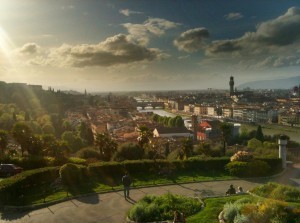
A view of Florence
Italians eat a late dinner so if I want to go somewhere fancy, I go early – around 7:30 – to avoid the need for reservations or around 9pm if I’m going to a small local shop. In all cases, the food is fantastic.

The definition of pizza
Describe an interesting conversation you had with a local:
I have had a number of conversations with Italian business owners, particularly in Rome. The frustration and exhaustion they express at their political corruption is stronger than the local coffee.
One young man went do far as to say that he “hoped the recession was the worst ever so that we can destroy the foundation and build up again”. In conversations with young business owners around Italy, one can taste the venom they have for the situation they have been put in but also the optimism that, if only they could drown the corruption, maybe a beautiful and prosperous country could emerge.
What do you like about where you are? Dislike?
My wife and I have always been welcomed by our host country but it is often with a smile and a handshake. When we arrived in Rome, it was literally to a hug, open arms and an invitation to join at the family dinner table. Never have we felt so warmly welcomed by the people.
That said, I have never seen the social and economic devision between store owner – those selling pizzas and suit jackets – and street vendor – those selling sun glasses and knock off designer handbags – so strikingly clear.
I don’t judge anyone or any country but it seems clear that more needs to be done to address the separation which is played out on each street corner in Italy. I fear that the economic recession will only apply more pressure to this cauldron and can not possibly lead to positive things.
Describe a challenge you faced:
While I was sitting at a bus stop, an old italian man pulled up in a car and jumped out as quick as he could to ask me for directions to Venice. In Italian.
I don’t speak italian and after a few minutes of hand waving, iPhone pointing and map circling I think I pointed him in the right direction. It wasn’t easy trying to describe the various turns and bends he needed to take. I hope he got there correctly.
What new lesson did you learn?
First, remember that you don’t have to leave your own country to be in a strange and unfamiliar place. Second, iPhone maps are not universally understood. Third, no matter where you are going, a smile and patience will get you there every time, regardless of language, culture or age divisions.
Where next?
Cape Town and a southern African safari.
Original article can be found here: Vagabonding Field Reports: Embraced in Italy
June 14, 2012
Vagabonding as a rock musician Post #7 – A Case Study: the Blues Against Youth
Vagablogging :: Rolf Potts Vagabonding Blog
This article is the fifth in a series of posts explaining how to bring your music on the road and get to travel with it. Read the series’ introduction , Post#1 , Post # 2 , Post #3 , Post #4, Post #5 and Post #6.
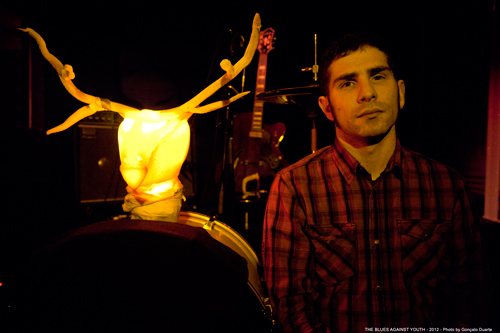
After a few posts explaining and suggesting how to get out and play your music travelling the world, I decided it is time to bring up a real example: The Blues Against Youth. This one-man band comes from Rome, Italy, although upon hearing you may think it is some piece of lost blues from Mississippi… nevertheless, it is a perfect example of how an independent musician has overcome its national boundaries and brought his music to a wider audience by, obviously, touring and travelling.
I asked Gianni -the guitarist and one man drummer – a few questions regarding the management of life on the road, wishing they may be useful and inspiring for others looking to expand their musical activities to the next level.
Do you think your dream of playing music around the world has fully realized?
Tough question  In the last two/three years I have been to many European countries. I like to play my music wherever there are people willing to hear it. “Playing my music around the world” is not exactly the main goal, as there are places I would like to go to, and others that do not appeal to me at all.
In the last two/three years I have been to many European countries. I like to play my music wherever there are people willing to hear it. “Playing my music around the world” is not exactly the main goal, as there are places I would like to go to, and others that do not appeal to me at all.
How do you manage to spend so much time playing music on the road?
Behind these long tours there is a massive booking work which is mainly conducted by myself without the aid of any agent. I have to write many emails and make infinite phone calls, and I get through a lot of stress trying to create a geographically logical route… however, once the tour is scheduled and I’m in the car ready to go, I just do it and feel free.
Do you think you can travel in the traditional sense of the term -seeing places and experiencing different cultures – as a touring musician?
Many times I don’t get the chance to see much of the cities I play, and it’s a pity; when other times it happens, I enjoy it very much. Anyways, by talking with people I meet on the road, sharing time with them, visiting their houses, their bars and knowing their friends I can usually have very mind-opening experiences. I realized that there are many ways of living, and mine constitutes only one of the many limited points of view. This confuses me at times, but by the end of my tours I feel much better.
How did you start getting shows outside of your home country?
I started by emailing people, telling them about my music and waiting for answers. It took a while to get a real response.
Is the logistic organization of your travels hard?
For me, the logistic organization is the most important thing. If everything is set at best, I get stressed out less. I generally travel on my own, and if something unexpected happens (which is usually a bummer), I have to make something up. By being well organized, it is easier to overcome such situations.
How are you received in the communities/cities/countries you visit?
It depends on where I go and what people I meet. In general I am received pretty warmly. I like when there’s some “love” behind any organization. I like to taste local food and drinks, to know about traditions concerning what I eat or drink. I like when there’s a cultural exchange. It also happens to play in colder environments, but luckily much fewer times. When it happens I get an instant feeling, and I get the blues. This may sound bad but on the other hand gets me in the right mood to write new songs.
Original article can be found here: Vagabonding as a rock musician Post #7 – A Case Study: the Blues Against Youth
A new mecca for historic auto buffs in–of all places–Tacoma, Washington
Vagablogging :: Rolf Potts Vagabonding Blog
A bit of travel news closer to home (for me, anyway). In Tacoma, Washington, thirty miles south of Seattle in the shadow of Mt. Rainier, is a brand-new museum which has become a pilgrimage site for historic auto enthusiasts. The one-month-old facility, called America’s Car Museum (ACM), showcases what was once the world’s largest private collection of rare cars.
The collection was amassed by wealthy Tacoma businessman Harold LeMay over many decades. By 1997, LeMay’s collection was cited by the Guinness Book of World Records as the largest private auto collection in the world with 2,200 vehicles. Following his death the LeMay family decided to open the hoard to the public, and ten acres of land next to the Tacoma Dome was developed into a campus including a four-story, 165,000-sq.-ft. museum.
On June 2nd of this year the LeMay collection was put on display for the first time in its new home. The ACM will ultimately house up to 350 of the most historic autos from the LeMay collection as well as donations from other private owners. Exhibits include classic and futuristic cars, fire engines, tanks, motorcycles, tractors, horse-drawn wagons, and related “automobilia”, as historic auto enthusiasts call it. State-of-the-art racecar simulators and exhibits on alternate propulsion systems—including electricity, hydrogen, diesel, natural gas and bio-fuel powered vehicles— are also part of the experience.
The museum aims to become a gathering place where enthusiasts from around the globe can enjoy the previously private collection. The ACM expects about 500,000 visitors a year and plans to develop a 15,000 sq. ft. education center/library to promote automotive history, restoration, and preservation.
For those interested in the ACM, info can be found at http://www.lemaymuseum.org
Original article can be found here: A new mecca for historic auto buffs in–of all places–Tacoma, Washington
June 12, 2012
Thailand’s petting zoos: More harm than help?
Vagablogging :: Rolf Potts Vagabonding Blog
 Friends seem disappointed when I admit to skipping out on Thailand’s famed Tiger parks, or interactive zoos where tourists can safely cuddle up to entire tiger families. The photos are pretty cute, and there were plenty of times when I was certainly tempted. Now back in the US, I’ve become determined to uncover the truth about Tiger Temple, Tiger Kingdom, and all of the other hotspots for tiger-petting that I missed. What’s the catch? How are these trainers keeping the usually dangerous animals docile, unfazed by swarms of tourists creeping close for the perfect photo op? Are tigers truly safer in captivity, away from dangers of deforestation and poaching, or is this another case of animal exploitation for tourist dollars?
Friends seem disappointed when I admit to skipping out on Thailand’s famed Tiger parks, or interactive zoos where tourists can safely cuddle up to entire tiger families. The photos are pretty cute, and there were plenty of times when I was certainly tempted. Now back in the US, I’ve become determined to uncover the truth about Tiger Temple, Tiger Kingdom, and all of the other hotspots for tiger-petting that I missed. What’s the catch? How are these trainers keeping the usually dangerous animals docile, unfazed by swarms of tourists creeping close for the perfect photo op? Are tigers truly safer in captivity, away from dangers of deforestation and poaching, or is this another case of animal exploitation for tourist dollars?
Having visited Argentina’s Zoo Lujan petting zoo in 2007, I can tell you that posing with a tiger is truly a thrill. I was giggling away with my camera, and I admit that the photos from that day at the “zoo” are some of my most unique. They certainly evoked the most questions. Of course I second guessed the sincerity of the zoo’s mission statement, especially when the teenage zookeepers insisted that the tigers (many of them full grown males) were not drugged, but “raised with love.”
One of Thailand’s parks in particular has caught the attention of conscious travelers hoping to play with tigers and also help them. Animal conservation groups and concerned travelers, on the other hand, are trying to bring down Tiger Temple for good.
Just outside of Bangkok, Tiger Temple is the oldest Buddhist school and forest temple in Western Thailand. It’s a sanctuary that began caring for tiger cubs whose mothers had been killed, and they begin taming the animals starting at just three weeks. Their tiger population continued to grow through rescue missions and on-site breeding and now there are over 90. The entrance fee is about $20, and for $30 you can take a photo with one.
The park’s mission is to raise enough tigers to eventually begin releasing them into Thailand’s forests, and to also educate people on deforestation and poaching, but many animal activists groups and confused visitors find this suspicious. Care for the Wild International claims that the Tiger Temple is involved with animal trafficking, and other critics suggest that sedatives and abuse are to blame for the their suspiciously calm temperaments. The monks in charge continue to insist that the animals are safer there; that Tiger Temple is a sanctuary that keeps them healthy and safe.
A trip to Thailand’s zoos, parks, and interactive animal attractions are tempting, but don’t forget to do your research. Have any of you visited Tiger parks in Thailand? Do you have a different opinion?
Here are some fabulous resources to check out before signing up for an animal tour in Thailand, or anywhere else in the world!
Original article can be found here: Thailand’s petting zoos: More harm than help?
June 11, 2012
What do guidebooks say about your country?
Vagablogging :: Rolf Potts Vagabonding Blog
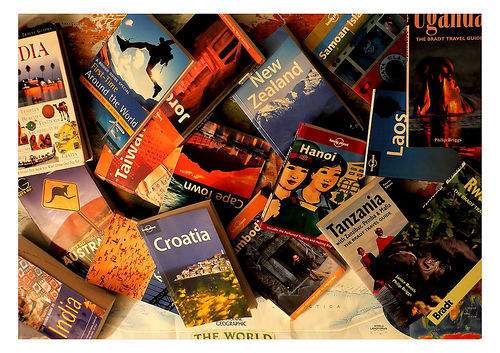
Various travel guidebooks. Photo: iandoh / Flickr
The Atlantic had an article titled Welcome to America, Please Be On Time: What Guide Books Tell Foreign Visitors to the U.S. It was a little disorienting to read about your own country from the perspective of a foreigner. When you live in a place where you grow up, it doesn’t occur to you to pick up the tourist literature. For context, Lonely Planet is an Australian company (although now owned by the BBC), while Rough Guides are based in England.
What guidebooks say can be less than flattering. An excerpt:
Lonely Planet urges caution when discussing immigration. “This is the issue that makes Americans edgy, especially when it gets politicized,” they write, subtly suggesting that some Americans might approach the issue differently than others. “Age has a lot to do with Americans’ multicultural tolerance.”
Ouch. On the other hand, what’s enlightening about seeing things from an outsider’s perspective is that it points out differences you otherwise would have overlooked. If you’re an American, you’d assume you wouldn’t sit at a stranger’s table and just strike up a conversation. Yet this is normal in more crowded, communal countries where people share everything.
A particularly American norm that drives visitors crazy is tipping. My friends from other countries have reacted with confusion, anger and frustration over how to handle this. One Kiwi friend said flat-out, “I hate tipping. It reduces all contact with service people to a financial transaction. Why can’t America just pay them a living wage like civilized societies?”
I’d like to hear from our readers. What countries are you from? What have you read about your country in guidebooks? What was true and what was false? Please share your thoughts in the comments.
Original article can be found here: What do guidebooks say about your country?
June 10, 2012
The travel narrative is the oldest in the world
Vagablogging :: Rolf Potts Vagabonding Blog
“The travel narrative is the oldest in the world, the story the wanderer tells to the folk gathered around the fire after his or her return from a journey. “This is what I saw” — news from the wider world; the odd, the strange, the shocking, tales of beasts or of other people. “They’re just like us!” or “They’re not like us at all” The traveler’s tale is always in the nature of a report. And it is the origin of narrative fiction too, the traveler enlivening a dozing group with invented details, embroidering on experience.”
–Paul Theroux, The Tao of Travel (2011)
(2011)
Original article can be found here: The travel narrative is the oldest in the world
June 9, 2012
Travel writers: Francis Tapon
Vagablogging :: Rolf Potts Vagabonding Blog
Francis Tapon was born and raised in San Francisco, California and has traveled to over 75 countries. He co-founded a successful Silicon Valley company, and he has also worked at Hitachi Data Systems and Microsoft. He thru-hiked the Appalachian Trail and the Pacific Crest Trail. In 2007, he became the first person to do a round trip on the Continental Divide Trail. He wrote Hike Your Own Hike: 7 Life Lessons from Backpacking Across America and The Hidden Europe: What Eastern Europeans Can Teach Us
and The Hidden Europe: What Eastern Europeans Can Teach Us . He has a degree in Religion from Amherst College and an MBA from Harvard Business School.
. He has a degree in Religion from Amherst College and an MBA from Harvard Business School.
How did you get started traveling?
Soon after I was born. Although I was born in San Francisco, my mom is from Chile and my dad was from France. Therefore, to see any relatives, we had fly a long way. My first big solo trip was right after college: the classic Western European tour that many college grads do. My first big backpacking trip was thru-hiking the Appalachian Trail.
How did you get started writing?
While I was hiking the Appalachian Trail, I wanted to summarize the lessons I learn from the trail. So I penned my first book, Hike Your Own Hike.
What do you consider your first “break” as a writer?
Getting on to the most-listened to radio station in America: KQED. I was interviewed for one hour on Forum with Michael Krasny. It’s a San Francisco Bay Area radio show that I had listened to many times. I had always admired Krasny’s interview skills and general intelligence. He is a hero of mine. Therefore, I was thrilled to get an hour on his show to talk about The Hidden Europe, my second book.
As a traveler and fact/story gatherer, what is your biggest challenge on the road?
Language barriers. Although I’m fluent in Spanish and French, and I can vaguely understand Portuguese and Italian, there are still hundreds of languages that I can’t speak. It’s frustrating when I meet an old person who I’m sure is filled with fascinating tales and I can’t get those stories out of him or her. I usually find young people to help me translate, but often even young people can’t speak one of my languages. So sometimes I can’t get the story.
What is your biggest challenge in the research and writing process?
Knowing when to stop researching. You can spend your whole life reading and researching almost any subject. At some point, you have to say, “That’s enough, I’m going to start writing.”
The biggest challenge for writing is ignoring the Internet drug. The temptation of wasting hours on the Internet is monumental. The only way I solved it was living in a house in village in Croatia that had a great view of the Adriatic, but no Internet at all. Once a week I would check email. I would also download Wikipedia pages and read them at home. I was disconnected for about one year.
What is your biggest challenge from a business standpoint?
Writing is a horrible way to make money. So from a business standpoint and as a Harvard MBA, I must say that there’s are so many other ways to make money that are far superior than writing. Do NOT do it for the money. Please. In fact, you could lose money just doing the promotion.
Promotion is the toughest part. There’s a common myth that if you just write a brilliant book, you just have to sell it to 100 people and then word-of-mouth will turn it into a bestseller. Then you can sit back and collect checks. Wrong! Excellent writing helps sell the book, but ultimately you have to relentlessly promote it, at least until you have a few thousand of true fans. Not 2,000 Twitter followers or 2,000 Facebook “Likes.” No. You need at least 1,000 rabid, I’ll-buy-and-spread-the-word-of-whatever-drivel-you-write fans. Getting that critical mass is one of the toughest things a successful writer must achieve.
Have you ever done other work to make ends meet?
I saved most of my money during the four years that I consulted for Microsoft and Hitachi. I’ve been living off my savings ever since. My book revenue provides a trickle of revenue that helps, but, so far, is not enough to keep me from tapping into my savings every month.
Fortunately, frugal vagabonding can cost roughly $10,000 a year, so I can avoid “real” work for a long time. I hope that somewhere along the line my book and services (public speaking, guiding, personal coaching) will start producing enough revenue that it will exceed my expenditures so that I can stop digging into my savings every week. That gets old after a few years.
What advice and/or warnings would you give to someone who is considering going into travel writing?
Don’t quit your day job unless you have enough money to sustain yourself for at least three years. Even after you finish writing your book, it takes a long time to publish and promote it. You won’t see revenue for years. And even when the money starts to flow, it’s usually just a trickle and rarely goes beyond that. Do your best to be the exception to this rule, but at the same time don’t bank on being the exception (unless you have a big bank account).
What is the biggest reward of life as a travel writer?
The flexibility and the joy of doing what you love. Everyday someone tells me, “Francis, you’re living the dream.” Amen. I’m profoundly grateful everyday that I’m travel writer.
http://francistapon.com
ft@francistapon.com
Original article can be found here: Travel writers: Francis Tapon
Vagabonding Field Reports: Road Trip through the Gobi Desert
Vagablogging :: Rolf Potts Vagabonding Blog
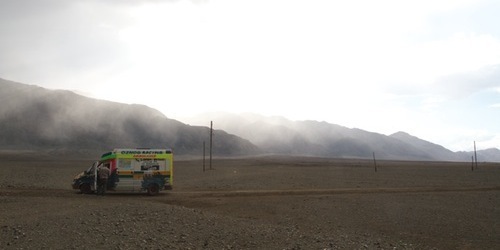
(CP> I’m preparing for my next trip overseas, so this month I decided to share a trip I took in 2010, as part of the Mongol Rally. If you’re looking for an irreverent race that is challenging, yet incredibly fun, check it out.)
Cost/day: ~$40/day (food / gas)
What’s the strangest thing you’ve seen lately?
I’m fairly sure that we are the strangest thing anyone has seen lately. Three chaps, who haven’t showered in weeks, in an obnoxiously fluorescent ambulance being held together by duct tape, driving through the Gobi Desert.
 Describe a typical day:
Describe a typical day:
Once we hit Mongolia, our days became all about necessities: food, gas, drive, fix the ambulance, sleep – repeat as necessary. I’m sure that this may seem monotonous, but I found it freeing. Instead of worrying about all of the inconsequential stresses in our daily lives, I was forced to worry only about what truly mattered – survival and moving forward. Somehow, these stresses and the focus they require made me feel much more… connected to everything around me. It was the same “in the moment” feeling that I love about riding motorcycles — just spread out over a much longer period in time.
Describe an interesting conversation you had with a local:
Outside of the major cities and towns, few people that we ran into spoke English. Instead, our conversations were a mixture of words, pointing and improvised sign language. I am amazed by how much you can convey in this manner. Specifics are hard, but sharing a a general story or concept is easy — just one of the joys of being human.
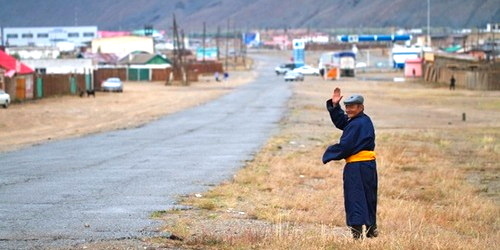
Entering a town
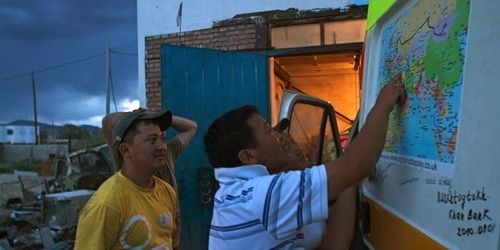
Making new friends
The most unexpected conversation that we had, was with the sister of a man (Bolt) who invited us into his yurt one evening. She was fixing us dinner (warm goat milk soup with various meats and cheeses) and was the most stoic woman I’ve ever met — especially with a meat cleaver in hand. As we looked around the yurt, we noticed some trophies on a shelf. When we asked what they were, she stood up, moved over to a cabinet and pulled out a large vinyl roll. When she let it unfurl, we saw a picture of her holding a trophy and a ping pong paddle. She never smiled (in the picture or in real life), but I could tell she was immensely proud. Bolt later explained that she was the Mongolia ping pong champion and had once won the international championship. What are the odds?

Inside a Mongolian Yurt
What do you like about where you are? Dislike?
The landscape and vistas were easily the best thing about the trip. Each day, I had my breath taken away, both by the enormous expanse of the landscape and by how much the terrain changed.

Road, Mongolia

Mountain Pass, Mongolia

Vista, Mongolia

Totem on Hill, Mongolia
My only dislike was that we had a deadline (self-imposed) to make it to Ulaanbaatar, so we didn’t get to go on many random side-trips. We spent weeks driving through Mongolia, though it was only a taste of the country. I definitely would like to return to explore certain regions.
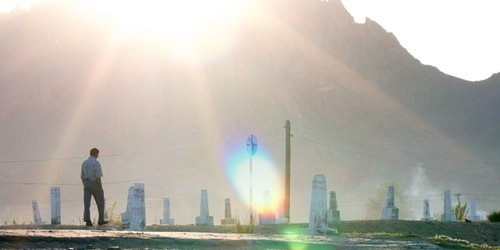
Describe a challenge you faced:
Just trying to keep an ambulance running was the biggest challenge and deserves it’s own story. I won’t go into everything here – suffice to say that the Mongolia roads destroy vehicles. During the 1700+ miles that we drove through Mongolia, we:
lost our side door and fender
had to strap down our hood with a rope
fractured our windshield
lost a fan belt
destroyed our front suspension and wheel well
had an electrical fire, losing our lights and alternator
broke the emergency brake
cut a brake line, disabling our normal brakes (we then used gearbox to slow down)
killed our starter (and had to rely on push-starting)
destroyed our front suspension and wheel well
broke the frame (our passenger door was strapped shut, becoming a structural component)
What new lesson did you learn?
I learned the power of community support. In Mongolia, the terrain is so rough and many of the vehicles are so worn, that the worst often happens. Since there is no formal support (AAA anyone?), people help each other out. It actually reminds me a bit of Burning Man. You are ultimately responsible for yourself, but are often surprised by the generosity of strangers.
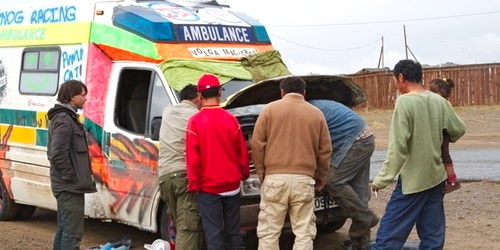
Community Effort - Fixing the Ambulance
We were saved multiple times by others – especially when torrential rains turned the desert into a huge mud bog. However, we also did our best to return the favors – whether giving oil to a couple on a motorcycle, or trying to pull a truck out of the mud. (Have you ever seen an ambulance try to pull a semi-truck? Hilarious!)
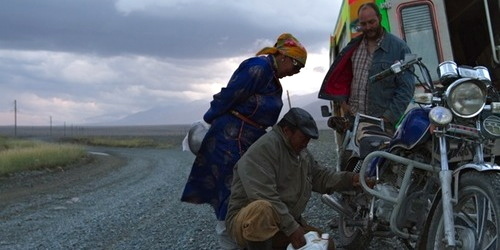
Do onto others...
Where next?
I’m beginning a road trip across America, so that I can visit with my family and close friends before I head over to Singapore and Australia for several months. Over the next few weeks, I’ll drive about 6000 miles, from Philadelphia to Ohio, Missouri, South Dakota, Washington, Texas, New Mexico, Colorado and then back to South Dakota.
I absolutely love driving these long stretches. There’s something almost therapeutic about it; like a form of meditation. Once I’ve been driving for a few hours, deep thoughts seem to bubble up, allowing me to work through unresolved issues, to reflect on recent actions or to plan out where I’m headed.
See you on the road!
Original article can be found here: Vagabonding Field Reports: Road Trip through the Gobi Desert
June 8, 2012
Vagabonding field reports: in Miyako with Ayako
Vagablogging :: Rolf Potts Vagabonding Blog
Mahema beach, regarded by many as Japan's best beach
Located 300km South of Okinawa, Miyakojima and his tiny surroundings islands, are the quintessential beach destinations. This almost completely flat islands retain a very traditional living, where the day is spent working in the sugar cane fields or fishing with little boats. Miyako ancient culture has survived much better than his famous neighbor Okinawa.Cost/day: Monthly rate for dorm in a Guesthouse where I was alone for 2 month (except a week during the Triathlon event) 30.000Y (12,5$ a day)
Karate classes 3 times a week: FREE
Surgery : about 400$ FREE (A huge thanks to Dr. Uchide)
Neverthless, with the only luxury of some meals at Restaurants, I couldn’t manage to spend less than 1000$ a month. Miyako maybe the less japanized island in Japan, but they still use the same currency.
What’s the strangest thing you’ve seen lately?
It’s a custom that they share with most of Asians, but Japanese people take it to extreme level: they go to the beach like they go to a war. They cover every inch of skin they can, wear huge hats, don’t walk barefoot on silky sand, don’t swim without a wet shirt or don’t snorkel without fins and a wetsuit, even if the water is warm enough for my picky Mediterranean habits. And rarely spend more than 30′ overall, even in Miyako, where there is really little else to do.
So during my two months here, I could enjoy the most beautiful beaches in Japan, like the stunning 7km long Maheama, plenty of time just by myself. And even if I never remained at a beach longer than a couple of hours, I did not notice once someone who was there when I arrived and still there when I left.
Describe a typical day:
I was in Miyako during the busiest period of the year: the yabijy, the Strongman Thriathlon, Golden week. But even in those special days I never experience a crowd or saw someone in a rush.
Miyako is an ideal place for exercising, and I tried to exercise every day, being it cycling, running, swimming, karate or just going for a walk. I spent as much time as possible with Ayako, but most of the time I was in front of a computer pretending to study Japanese or just writing, browsing, too often wasting time. In my plans I wanted to do some volunteering in the fields to learn about farming, but for one reason or another it didn’t worked.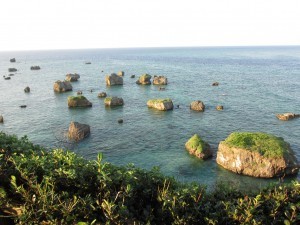
Higashi Hennazaki, one of my favourite spots in Miyako
Describe an interesting conversation you had with a local:
If I stayed 2 months in Miyako it’s because of Ayako, who, after working for years as a tour guide, moved here 4 years ago from Tokyo to work for a big hotel. We connected immediately and soon she become more than a guide, more than a friend. Ayako is in love with Miyako, and while living last year in Colombia I discovered how good is Ajaco, in Miyako I quickly learned to love Ayako.
What do you like about where you are? Dislike?
Miyako is a paradise island: white beaches, blu waters protected by corals. the people proud of their traditions but authentically welcoming with the visitors. Apart a bunch of English teachers there are no expats. Even the number of Japanese visitors is surprisingly low, despite all the talk of a “boom”, which probably lies more in the wishes of the local tourist office that in the real traffic. This is a place that if you are not scared by silences and tranquillity, you can feel your in a couple of days.
Disliked: Otori with awamori: local men gather together drinking and drinking, following this ritual that in turn someone has to give a speech before pouring his cup and everyone else in the circle. It may sound funny, but I don’t like the taste of Awamori and I don’t like getting stupidly drunk at the same speed a japanese leave a beach.
Describe a challenge you faced:
Studying Japanese. I love learning languages and I can proudly affirm I am able to sustain advanced conversations in four (and half) different idioms, but learning Japanese, his 3 alfabets, words that has nothing resembling a translation in a language I know, proved to be too much for me. I am leaving Japan after 3 months frustrated, because I am still lost even in a basic exchange.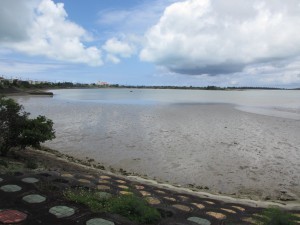
Shimoji bay, near the place where I lived in Miyako
What new lesson did you learn?
I don’t recommend you to travel without an insurance like I am doing, even if in most of the countries is not really necessary, but when you are in an expensive country and have to face a medical emergency you can’t always count of the generosity of Dr Uechi, that because I was sent by his friend Tomori, our karate sensei, blabla. In fact I had to go to the hospital again in Okinawa, just before leaving Japan, and it cost me 5.000 Yen for a simple check up.
Where next?
My tourist visa expired and it’s time to to leave Japan. I will go back in Miyako and Ayako in August, but before I am going to discover a new country, Korea, and come back to one of my favourites: Malaysia.
Original article can be found here: Vagabonding field reports: in Miyako with Ayako
Rolf Potts's Blog
- Rolf Potts's profile
- 323 followers


